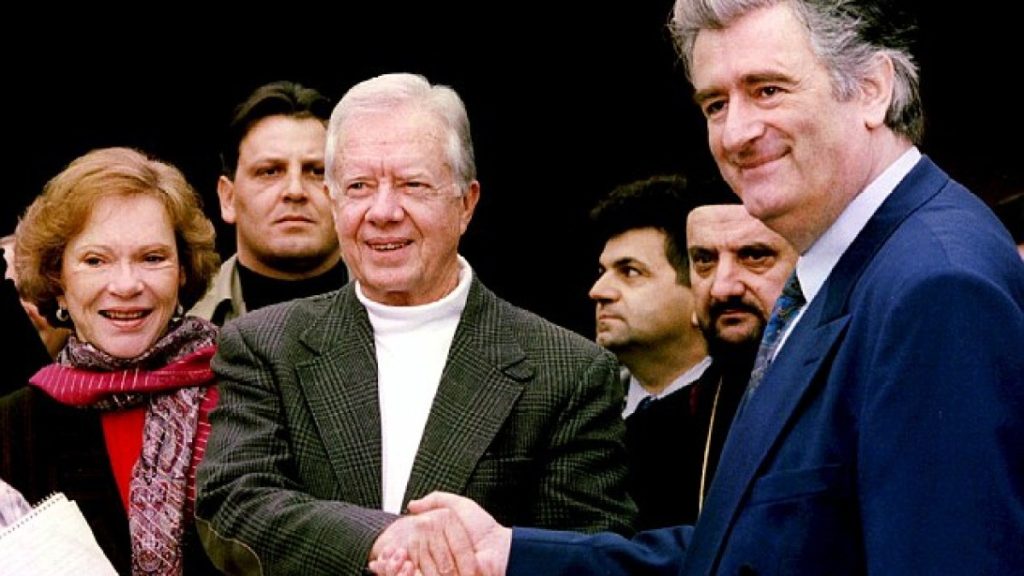When he lost to Ronald Reagan in the 1980 election, Jimmy Carter was only 56 years old. Too young for traditional political retirement and still with a purpose in life, he soon set out to make the most of his remaining years. He dedicated himself to establishing the Carter Center and pursuing a number of causes, including conflict resolution. Carter’s post-presidential life earned him accolades and the Nobel Peace Prize in 2002. In fact, he is widely regarded as an exemplary former president. In the process, he reinvented himself and the post-presidency.
In pursuing conflict resolution, Carter opted for private peacemaking and, in the process, removed the established norms expected of former presidents. His private diplomacy involved meeting and negotiating with unsavory figures deemed unworthy of a former president. As recently as 1994, Carter traveled to meet and negotiate with Kim Il Sung of North Korea and Raoul Cedras of Haiti. Negotiating with international pariahs led to criticism of Carter for providing them with time and even a degree of legitimacy. Perhaps the most controversial of his private peacemaking efforts up to and since was his 1994 meeting with Bosnian Serb rebel leader Radovan Karadzic and his military commander Ratko Mladic.
Just before Christmas 1994, Carter made a more than 5,000-mile trip from the United States to the Bosnian Serb stronghold of Pale outside Sarajevo. He was welcomed by the who’s who of the rebel leadership. The purpose of his trip was to broker a mid-winter ceasefire between the rebels and the Bosnian government. His meetings with Karadzic and Mladic raised eyebrows and were harshly criticized. The 39th US president met in 1994 with individuals the US State Department had listed as war crimes suspects in 1992. So what did Carter decide to do and why?
At the time of Carter’s trip, Bosnia had been at war for two and a half years with most of the country occupied by Bosnian Serb forces. The internationally recognized Bosnian government, having survived the initial attacks, was putting up serious resistance and had launched offensives aimed at recapturing occupied lands. The broad outlines of an international peace plan known as the Contact Group plan, drawn up in the summer of 1994, were accepted by the Bosnian government and rejected by the Bosnian Serbs. The winter of that year would serve as a respite before major Bosnian government military operations were expected in the spring of the following year. It is against this background that Carter traveled to Bosnia in December 1994 to broker a ceasefire.
Carter was approached by Bosnian Serb emissaries who had visited the former president in Plains, Georgia with a request for his involvement. The Clinton administration was ambivalent about Carter’s trip and kept its distance without openly opposing it. The Bosnian government was concerned that this was Karadzic’s PR ploy to get a former US president to visit, but was unable to prevent it.
When he landed in Sarajevo, Carter got a first-hand feel of the Bosnian capital under siege, which he recalls in his memoirs. Bosnian government officials, convinced that Carter had been duped into making the trip, offered a lukewarm reception. By contrast, the mood in Pale the next day was jubilant. No person of higher political status and world fame had graced this city with a visit. Negotiations produced an agreement for a four-month ceasefire.
All the actors involved followed the ceasefire, but for different reasons. The pale Serbs turned out to be the main beneficiaries of Carter’s private diplomacy. Far more important than a temporary truce was the opportunity to host a former POTUS in their stronghold and brief him on Serbian grievances. Carter’s mere presence at the Pale was a major publicity coup. This public relations success led Karadzic to exaggerate his expectations for Carter’s possible future involvement. In fact, Karadzic tried to involve Carter in Bosnia again in 1995, but without success.
The Bosnian government was unhappy with Carter’s trip, but did not want to derail his mission. In any case, seeking to make the most of a developing situation, Sarajevo demanded that the ceasefire be extended to the entire country and thus free the besieged northwestern enclave of Bihac from further attacks.
Instead of achieving peace, Carter’s truce turned out to be just a lull in war. The winter break was a prelude to major fact-shifting offensives launched by the Bosnian and Croat armies in the summer of 1995, which helped pave the way to an end to the war. It was in November 1995 that negotiations resulted in the Dayton Peace Accords.
Although Carter’s understanding of the war in Bosnia was sketchy, his determination to play peacemaker – a trait not uncommon in the former president – overcame any concerns that more seasoned peace hands might have had. His initiative in Bosnia stands as another example of his post-presidential activism.
However, one tainted with controversy.
The image that most clearly captured the full controversy of Carter’s trip was a photograph of the former president and Bosnian Serb leader. The photo-op of the two declaring a ceasefire in December 1994 in Pale was difficult. The former US president, who had emphasized human rights in office and beyond, was accompanied by the “architect of the Bosnian genocide” – to borrow a description of Radovan Karadzic from the Bosnian American scholar Robert J Donia.
Today, with his passing at the age of 100 on December 29, the world is remembering former President Carter as a statesman and human rights advocate who remained committed to building peace.
But his trip to Pale and meeting with Karadzic, immortalized in the photograph taken almost exactly 30 years ago, remains a major blot on his long and influential post-presidential career.
The views expressed in this article are the author’s own and do not necessarily reflect the editorial position of Al Jazeera.


